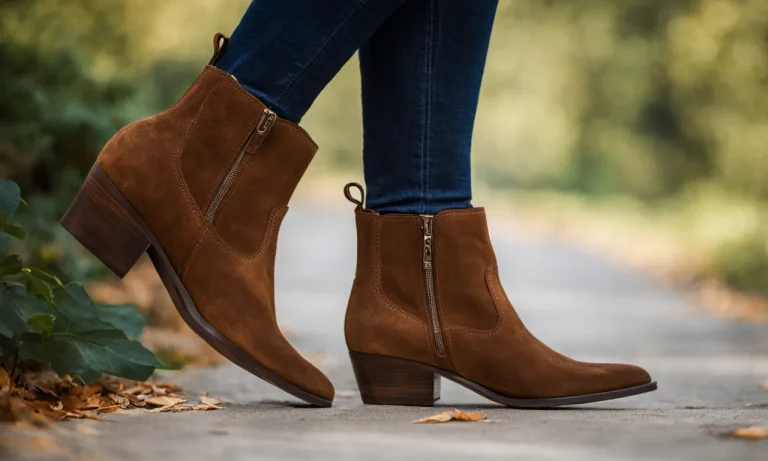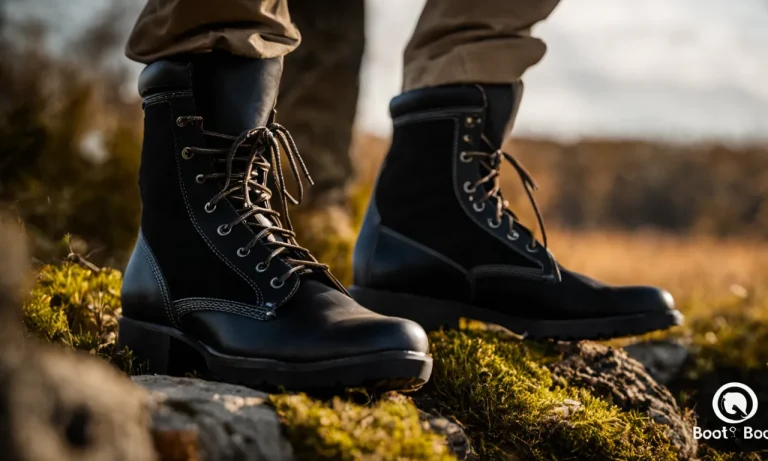If your favorite pair of sneakers has come unglued, you may be wondering what type of adhesive can reattach rubber soles securely. With so many glues on the market claiming to fix rubber, knowing which one to choose can be confusing.
If you’re short on time, here’s a quick answer to your question: Look for a contact cement made specifically for rubber and fabrics, like Barge or Shoe Goo. Apply to both surfaces, let dry, then press together firmly.
In this comprehensive guide, we’ll discuss the leading types of shoe glue for rubber soles and factors to consider when selecting the best adhesive for your repair project.
What Makes Good Shoe Glue for Rubbers?
When it comes to repairing shoes with rubber soles, using the right glue is essential. Not all glues are created equal, and some may not provide the strength or flexibility needed to effectively bond rubber materials. Here are a few key factors that make a shoe glue suitable for rubber soles:
Strong Bond on Rubber
A good shoe glue for rubber soles should be able to create a strong and long-lasting bond. Rubber is a flexible material that requires a glue capable of adhering to its surface effectively. Look for a glue that specifically mentions its suitability for rubber or has a strong bonding strength.
This will ensure that the repaired soles stay intact, even with regular use and exposure to different weather conditions.
Flexible When Dry
Rubber soles need to maintain their flexibility even after being repaired. A high-quality shoe glue will dry to a flexible finish, allowing the rubber to move naturally without compromising the bond. This is especially important for shoes that undergo frequent bending or twisting, such as athletic shoes or work boots.
A flexible glue will prevent the repaired sole from cracking or peeling over time.
Waterproof
Shoes are often exposed to various elements, including water. A good shoe glue for rubber soles should be waterproof to protect the bond from moisture and humidity. This will prevent the glue from deteriorating and ensure the repair lasts longer.
Additionally, a waterproof glue will also prevent water from seeping through the repaired area and potentially causing discomfort or damage to the foot.
When shopping for shoe glues, it’s helpful to read product reviews and consider recommendations from reputable sources. Websites like www.shoerepairguru.com or www.shoeadviser.com offer valuable insights and comparisons on different shoe glues available in the market.
Remember to follow the manufacturer’s instructions for application and allow sufficient drying time to achieve the best results.
Top Glue Recommendations for Rubber Soles
Barge Cement
Barge Cement is widely regarded as one of the best glues for rubber soles. It is a powerful adhesive that creates a strong bond between the rubber sole and the shoe upper. This cement is known for its durability and long-lasting hold, making it a popular choice among professionals and DIY enthusiasts alike.
Barge Cement is also resistant to heat and water, providing added protection for your shoes. You can find Barge Cement at most hardware stores or online retailers.
Shoe Goo
Another top recommendation for rubber sole repair is Shoe Goo. This adhesive is specifically designed for fixing shoe soles, including rubber soles. Shoe Goo forms a flexible bond that can withstand everyday wear and tear. It is easy to use, dries clear, and provides excellent adhesion.
Whether you need to repair a small tear or attach a loose section of rubber sole, Shoe Goo is a reliable option. You can find Shoe Goo at shoe repair shops or online retailers.
E6000
E6000 is a versatile adhesive that can bond a wide range of materials, including rubber. It is known for its industrial strength and durability. E6000 forms a permanent bond that is resistant to water, chemicals, and temperatures.
This adhesive is ideal for repairing rubber soles that are subjected to harsh conditions. E6000 is readily available at craft stores, hardware stores, or online retailers.
Gorilla Glue
Gorilla Glue is a popular adhesive that can be used for various applications, including repairing rubber soles. It is known for its incredible strength and versatility. Gorilla Glue bonds quickly and securely, providing a long-lasting hold.
This adhesive is also water-resistant and can withstand extreme temperatures. You can find Gorilla Glue at most hardware stores or online retailers.
Using Shoe Glue on Rubber Soles
When it comes to fixing shoes with rubber soles, using the right glue is crucial for a long-lasting repair. Whether you’re dealing with a detached sole or a small tear, investing in a high-quality shoe glue can save you both time and money.
This article will guide you through the process of using shoe glue on rubber soles, covering surface preparation, glue application, and pressing and drying time.
Surface Preparation
Before applying shoe glue to your rubber soles, it’s important to properly prepare the surface. Start by cleaning the area with a mild detergent and warm water to remove any dirt, dust, or debris. Once the sole is clean and dry, use a fine-grit sandpaper to roughen up the surface slightly.
This will create a better bond between the glue and the rubber. Be careful not to sand too aggressively, as it may damage the sole.
Glue Application
Choosing the right shoe glue is essential for a successful repair. Look for a glue specifically designed for rubber soles, as they offer a strong and flexible bond. Apply a thin and even layer of glue to both the rubber sole and the area where the sole needs to be attached.
Use a brush or a small spatula to spread the glue evenly. Make sure to cover the entire surface to ensure a solid bond.
Pro Tip: For added strength, consider applying multiple layers of glue, allowing each layer to dry completely before applying the next one.
Pressing and Drying Time
Once the glue has been applied, carefully press the rubber sole onto the designated area. Apply pressure evenly to ensure a secure bond. Some glues may require clamping or the use of weights to hold the sole in place during the drying process.
Consult the instructions provided by the manufacturer for specific guidelines.
It’s important to allow the glue to dry fully before using the shoes. Drying times can vary depending on the type of glue used, so refer to the product instructions for guidance. Avoid putting any stress or weight on the repaired area until the glue has completely cured.
This will help ensure a strong and durable bond.
Remember, using the right shoe glue and following the correct application process is key to fixing rubber soles effectively. By taking the time to properly prepare the surface, applying the glue evenly, and allowing for sufficient drying time, you can extend the lifespan of your favorite pair of shoes.
Shoe Glue vs Shoe Repair Adhesives
When it comes to fixing rubber soles on your favorite pair of shoes, using the right adhesive is crucial. In this article, we will compare two commonly used types of shoe adhesives: shoe glue and shoe repair adhesives.
Understanding the differences between these options will help you make an informed decision for your shoe repair needs.
Contact Cement vs Bargain Glue
Contact cement is a popular choice for shoe repairs due to its strong bonding properties. This type of adhesive forms a permanent bond between materials and is highly resistant to heat, water, and chemicals. It works well on rubber soles as it provides a reliable and long-lasting hold.
On the other hand, bargain glues may be tempting due to their lower price, but they often lack the strength and durability needed for shoe repairs. Investing in a high-quality contact cement will ensure that your shoe soles stay securely in place for an extended period of time.
For those on a budget, it’s worth noting that while contact cement may be more expensive upfront, it offers better value in the long run. With its superior adhesive properties, you won’t have to worry about your repaired soles coming loose or needing frequent touch-ups.
Rubber Cement vs Super Glue
Another option for shoe repairs is rubber cement. This type of adhesive is specifically designed to bond rubber materials together. It provides a flexible and durable hold, making it ideal for repairing rubber soles. Rubber cement is also easy to apply and dries clear, ensuring a seamless repair job.
On the other hand, super glue is a popular all-purpose adhesive known for its quick-drying and strong bonding properties. While it can work well for small repairs, it may not be the best choice for fixing rubber soles in the long term.
Super glue tends to harden and become brittle over time, which can lead to the soles cracking or separating.
Shoe Glue Tips and Tricks
When it comes to repairing rubber soles, using the right shoe glue is essential. Here are some tips and tricks to help you achieve the best results:
Test First on Inconspicuous Area
Before applying any shoe glue to the rubber sole, it’s important to test it on an inconspicuous area of the shoe. This will allow you to see how the glue reacts with the material and ensure that it provides a strong bond without causing any damage.
By testing it on a small area, you can avoid any potential mishaps and ensure that the glue is compatible with the rubber sole.
Use Solvent to Clean Excess Glue
When using shoe glue, it’s common to have some excess glue squeeze out from the edges. To clean this up and achieve a neat finish, it’s recommended to use a solvent. Acetone or rubbing alcohol can work well for removing excess glue.
Simply apply a small amount of solvent to a cloth and gently wipe away the excess glue. This will give your repaired shoe a polished look and prevent any hardened glue from causing discomfort.
Consider Adding Reinforcement
If you want to ensure a long-lasting repair for your rubber soles, consider adding reinforcement to the glued area. This can be done by using a patch or strip of fabric, such as canvas or nylon, to provide additional strength and durability.
Apply the glue to both the rubber sole and the reinforcement material, and press them firmly together. This will create a stronger bond and make your repair more resistant to wear and tear.
Remember, when it comes to repairing rubber soles, using the best shoe glue is crucial. Take the time to test the glue, clean up any excess, and consider adding reinforcement for a repair that will stand the test of time.
Conclusion
Finding the right glue is key to successfully repairing rubber soles that have separated from uppers. Look for a flexible contact cement made to bond rubber, and prepare surfaces properly before gluing. With good technique, you can extend the life of favorite footwear.
Now that you know what to look for in shoe glue for rubber soles, you can resolve common sneaker sole issues. Just be sure to follow application directions for the strongest, longest-lasting bond.






